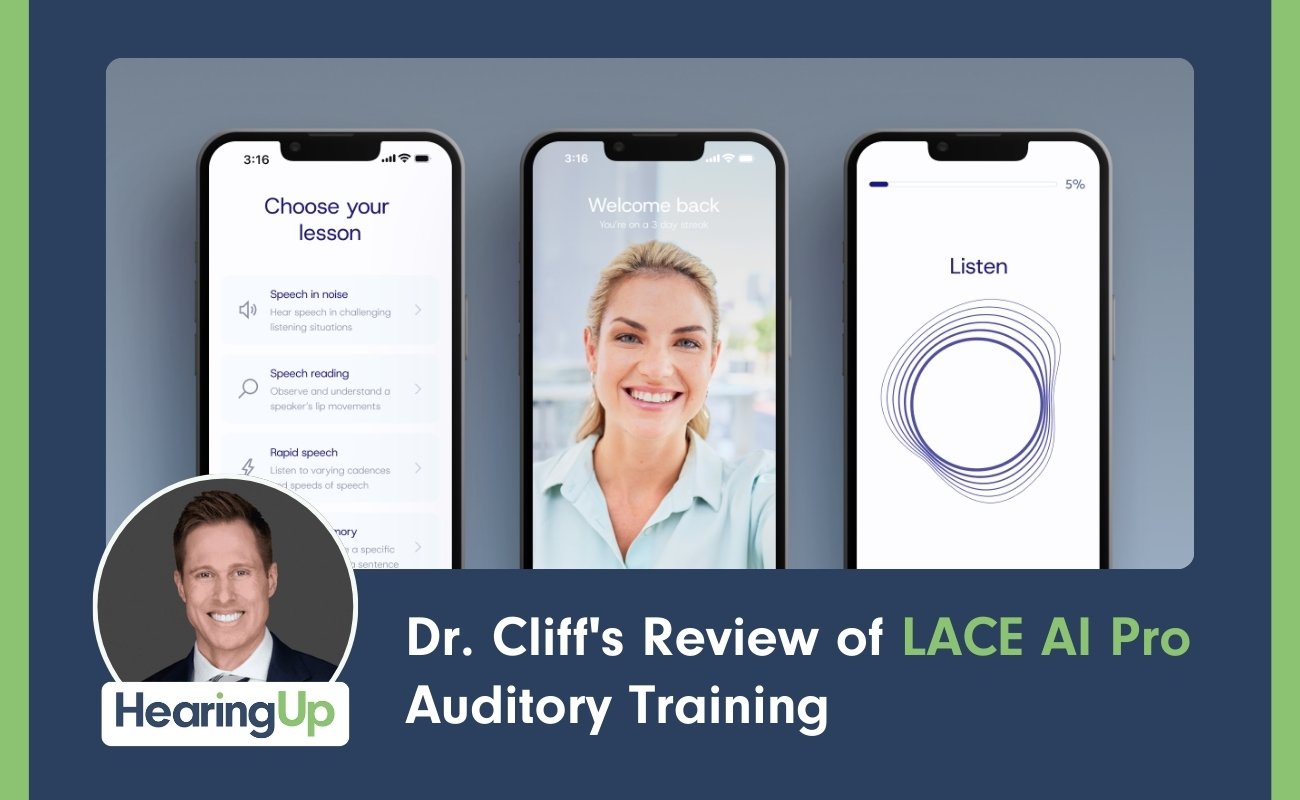The 7 Best Hearing Aid Features of 2025, According to Dr. Cliff
Dr. Cliff highlights 2025's top hearing aid features: equalizers, Bluetooth, AI neural networks, auto-adjustment, rechargeability, feedback control, and custom earmolds.
Dr. Cliff highlights 2025's top hearing aid features: equalizers, Bluetooth, AI neural networks, auto-adjustment, rechargeability, feedback control, and custom earmolds.

You might not realize just how far hearing aids have come in recent years. Back when hearing aids were first developed, they pretty much did one thing – amplify sound – and the only feature they had (other than being gigantic) was a volume wheel to make things louder or softer.
Fortunately, today's modern hearing aids do a heck of a lot more. While some features are flashy and grab all the headlines at events like the Consumer Electronics Show, other features fly under the radar but are arguably even more important to your hearing experience.
Let's dive into my top seven picks for the best hearing aid features available in 2025.
This first feature is critical but often overlooked when it comes to hearing aids.
When you develop hearing loss, you lose the audibility of sounds at different frequency ranges. During a hearing test, we can measure this loss and plot it on an audiogram. In most cases, some frequencies will have more hearing loss and others will have less.
This means a hearing aid needs to apply different levels of amplification to each of these frequency ranges and properly blend the amplification between them. If you only have a three-band equalizer inside your hearing aid programming software, you won't be able to customize the device to apply the exact right amount of amplification at each frequency.
However, when you increase the number of equalizer bands, it dramatically increases the precision with which your hearing care professional can match your prescriptive targets across the entire frequency range.
Over the years, the number of these equalizer bands has increased to 24 in some hearing aid manufacturer software. Premium devices like the Oticon Intent 1 and the Starkey Edge AI 24s offer this high level of precision. This is largely why I recommend that patients go with the highest level of technology they can reasonably afford – when you drop down in technology level, you start losing these frequency adjustment bands, which means we can no longer precisely match your hearing loss prescriptive targets.
As some of you might know, I was a US Marine Corps Scout Sniper, so it's no surprise that I prefer a precision rifle approach rather than a broad shotgun approach to programming. That's exactly why having a 24-band equalizer inside hearing aid programming software is one of the best features you can get in 2025.
That said, having lots of equalizer bands only matters if you go to a hearing care professional who follows comprehensive audiologic best practices.
Best practices include speech-in-noise testing, test box measures, validation, outcome measures, and crucially, Real Ear Measurement. Real Ear Measurement allows a professional to properly customize your equalizer bands to precisely match your hearing loss prescription.
If Real Ear Measurement isn't performed at your initial fitting appointment, then you have no idea if your hearing aids are programmed correctly – and spending money on hearing aids with 24 equalizer bands becomes a waste.
If you want an easy way to find a professional who follows these best practices, visit hearingup.com to find a HearingUp network member in your area. These providers have been vetted and are committed to following comprehensive best practices to ensure you hear your absolute best, no matter which hearing aids you choose.
The second feature making this year's list is Bluetooth LE Audio and Auracast Broadcast Audio.
LE Audio was actually inspired by the hearing aid industry back in the early 2010s because of our desire to have more universal connectivity with wireless devices. Bluetooth LE Audio uses the new LC3 Codec that provides better sound quality than other codecs, even at lower bit rates, which also means less battery drain.
Not only does Bluetooth LE Audio sound significantly better than previous Bluetooth protocols, but it also allows you to share your audio with anyone else who has Bluetooth LE Audio-enabled devices – whether hearing aids, headphones, or earbuds. Eventually, we won't have to adjust our treatment recommendations based on the type of Bluetooth in your smart devices.
But possibly even more exciting is Auracast Broadcast Audio. This new feature allows public venues to easily broadcast audio directly to patrons using an Auracast transmitter, which will eventually replace hearing loops and telecoils.
This means places like churches, museums, Broadway shows, sports bars and other venues will be able to send their audio directly into your hearing aids, enhancing your listening experience.
Just imagine if everyone could go into a sports bar and tap into the exact TV they wanted to hear! This capability will benefit not only people with hearing loss but also those with vision impairments who can access descriptive audio streams, as well as people with normal hearing using regular Bluetooth earbuds.
Because of this universal appeal, Auracast adoption will likely be broader and faster than what we saw with hearing loops and telecoils. Expect to start seeing Auracast availability on Google listings in 2025, as well as websites showing which venues have these transmitters.
Hearing aids that either have or are future-compatible with Bluetooth LE Audio and Auracast include the Oticon Intent, Signia IX, Starkey Edge AI, ReSound Vivia, and Phonak Infinio.
The third feature on our list is Deep Neural Network technology – and of course, any feature designed to help you hear better in background noise was clearly going to make this year's list!
Deep neural networks are relatively new in hearing aids, but they've been used for decades in other industries. Essentially, a DNN is an artificial brain trained with millions of sound samples, allowing it to use artificial intelligence to separate speech from background noise.
The first DNN in hearing aids appeared around 2021, but the technology has improved significantly since then. The results are genuinely impressive, with many users reporting dramatic improvements in noisy environments.
Artificial intelligence is allowing hearing aid manufacturers to significantly improve signal-to-noise ratio beyond what human engineers could achieve. Instead of maxing out at around 5-6 decibels of improvement, we're now seeing 10-13 decibels of signal-to-noise ratio improvement.
That's huge, considering that every one decibel improvement translates to approximately 10% better speech understanding in background noise. This is exactly why Deep Neural Network sound processing is one of the best hearing aid features in 2025.
Let's face it – you don't spend all your time in just one listening environment, so why would you want hearing aids programmed for only one situation?
You probably find yourself sitting in a quiet living room watching TV, then hopping in the car, driving to a restaurant, trying to have a conversation in that noisy restaurant, and then hanging out with family and friends. Each of these different listening situations requires different program settings for you to hear your best.
This means you have two options: either take out your phone and try to customize the audio yourself, or have hearing aids that do it for you automatically.
That's where automatic classifiers come in. Some hearing aids can identify different acoustic environments and adjust their settings on the fly. For example, the AutoSense OS 6.0 in Phonak Audeo Infinio hearing aids has six different classifications: calm situations, speech in noise, speech in loud noise, speech in car, comfort in noise, and music. The Widex Moment SmartRIC goes even further with 11 different classifications.
You might think you can adjust your own hearing aids better than an automatic system, but research shows these classifier systems often outperform manual adjustments. And if you're not confident making adjustments yourself, it makes even more sense to let the hearing aids handle it.
No matter your tech comfort level, an automatic classifier system makes a heck of a lot of sense, which is why it's on this year's list of best hearing aid features.
Since the new Reese's Law that went into effect in 2024 made disposable hearing aid battery packaging virtually impossible to open, rechargeable technology had to make this year's list!
Rechargeable hearing aid technology has come a long way, going from nickel metal hydride batteries that couldn't even get you through a full day, to silver zinc rechargeables that were so unreliable you had to wonder if they were designed to fail, to today's lithium ion technology that gives you quick charging, long battery life, and much better reliability.
Many new lithium ion rechargeable hearing aids only take 2-3.5 hours to reach 100% battery life. Need a quick charge? Just 15 minutes typically gives you an additional three hours of use. Premium models like the Starkey Edge AI and Signia IX can even deliver multiple days of battery life on a single charge.
Many modern charging cases store additional charges, so you don't have to keep your charger plugged into the wall all the time. It's also become much easier for people with dexterity or vision issues to use these chargers, as they now use magnets to pull the hearing aids into the proper position.
If your current hearing aids don't use lithium ion rechargeable batteries, chances are your next set definitely will. Even if you don't find rechargeability particularly exciting, it's still really important for a lot of people, which is why it's one of the best hearing aid features in 2025.
I don't think most people truly understand the significant impact that feedback suppression has on hearing aid capabilities.
Feedback is that whistling sound that occurs when amplified sound leaks out of your ear canal and recycles back through the microphones. It's a major issue for many hearing aid users because a lot of people with hearing loss have normal low-frequency hearing, which means we don't want to plug up their ear canals completely.
But when we leave the ear canal open and amplify sound, more of that sound leaks out, causing feedback. We could completely seal the ear canal with a power dome or closed custom mold to prevent feedback, but that would create other problems like insertion loss and occlusion effects – both very negative experiences.
So to amplify sound properly while keeping the ear canal relatively open, we need hearing aids with excellent feedback suppression. We can reduce feedback either by adjusting amplification in certain frequency ranges or by using technologies like phase inversion to cancel out the feedback.
Several hearing aids excel at feedback suppression, including the Oticon Intent and Starkey Edge AI. By effectively managing feedback, we can significantly increase amplification in the ranges where you need it while keeping your ear canals more open and preventing whistling.
This is why feedback suppression is so critical to hearing aid performance and why it deserves a spot on this year's list of best features.
If I'm being honest, a custom earmold is probably the hearing aid feature that would have the most significant benefit for most people with hearing loss.
You could have the world's best, most expensive hearing aids, and they still wouldn't perform well unless you can properly control the sound in the ear canal. Custom earmolds with acoustically optimized venting allow us to have the best of both worlds – we can amplify sound to the proper levels for your hearing loss prescription without having to completely plug your ears.
Custom earmolds are also extremely comfortable because they're designed specifically for your ear canals, and they have better retention, meaning they won't migrate out or fall out of your ears.
Here's the deal – the amount of hearing aid benefit that people leave on the table by not using custom earmolds would blow your mind. Approximately 80% of patients who come into my clinic require custom earmolds to hear their absolute best. But based on what hearing aid manufacturer reps tell me, only about 20% of people fit with hearing aids actually use custom earmolds.
This means a lot of hearing aid users are underperforming because the generic rubber domes they're using simply aren't adequate. Getting custom earmolds is simple – your hearing care professional either takes silicone impressions or, in more advanced clinics, performs 3D digital ear scanning.
Often, just adding a custom earmold with acoustically optimized venting can transform someone from absolutely hating their hearing aids to loving them. Here's a little secret: you can sometimes get custom earmolds for a lower-tier, less expensive hearing aid and outperform a more expensive premium device that's using generic domes.
Of course, the best solution is combining a premium hearing aid with a custom earmold. For many types of hearing loss, custom earmolds make much more sense than generic domes if you're trying to optimize your hearing performance, which is why this could be the most important feature on this year's list.
There you have it – the seven best hearing aid features available in 2025:
The best news? There are plenty of hearing aids from manufacturers like Phonak, Oticon, Starkey, Signia, Widex, and ReSound that include most or all of these features. If you're looking to get new hearing aids with the best features available, 2025 is definitely the year to do it.

Cliff Olson is an Audiologist and the co-founder of HearingUp and Applied Hearing Solutions in Phoenix, AZ. In addition, he runs and creates content for the popular DrCliffAuD YouTube channel.


Find a local hearing healthcare provider that has been personally vetted by Dr. Cliff and verified to use Best Practices in Audiology.

Phonak Virto Infinio custom aids offer comfort and discretion but face limits in complex listening versus behind-the-ear models.
Read More
Three methods confirm hearing aid performance: test box for specs, Real Ear Measurement for accuracy, and outcome assessments for effectiveness.
Read More
LACE AI Pro uses AI to deliver personalized auditory training, boosting brain processing skills beyond what hearing aids alone can provide.
Read More
Hearing aid costs cover technology, expert services like Real Ear Measurement and fitting, ongoing support, and admin fees—justifying the investment.
Read More
Dr. Cliff provides a comprehensive tutorial on the ReSound Smart App, covering its features, customization options, and advanced capabilities for hearing aid users.
Read MoreDr. Cliff reviews the Oticon OWN SI custom hearing aids, examining their invisible design, Deep Neural Network 2.0 technology, and performance trade-offs.
Read More
Dr. Cliff reviews the Widex Allure hearing aids, examining their minimalist design approach, new W1 chip technology, and notable feature reductions.
Read More
Dr. Cliff reviews the innovative Nuance Audio eyeglass hearing aids, examining their unique design, performance capabilities, and suitability for mild hearing loss.
Read More
Dr. Cliff gives a review of ReSound Vivia hearing aids, covering their AI features, connectivity, and performance in noise.
Read More
Name-brand hearing aids, fit by a local hearing healthcare provider who follows Best Practices.
Best Practices ChecklistHearing Aid Buyer's GuideWhile we review hearing products independently and opinions are our own, we are a member of various affiliate programs. This means that if you purchase through links on our site, we may receive a commission on that sale.